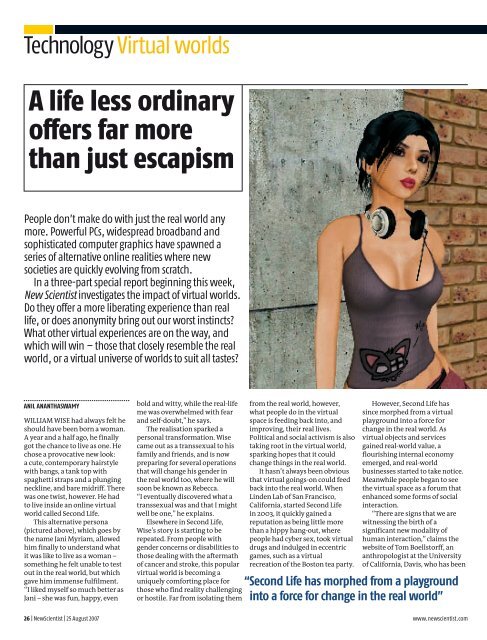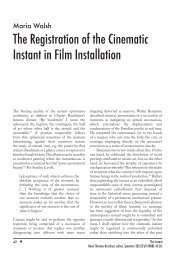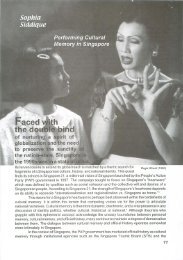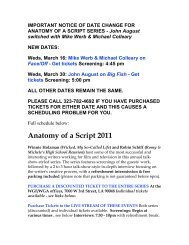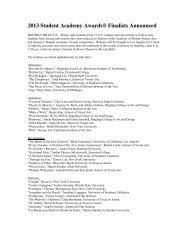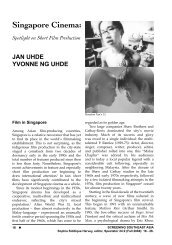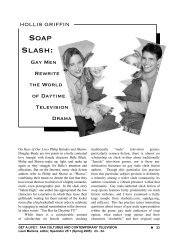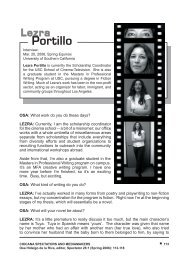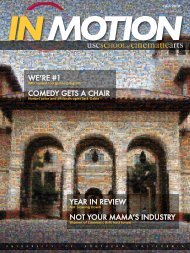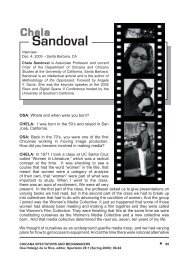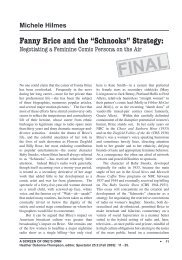A life less ordinary offers far more than just escapism - University of ...
A life less ordinary offers far more than just escapism - University of ...
A life less ordinary offers far more than just escapism - University of ...
You also want an ePaper? Increase the reach of your titles
YUMPU automatically turns print PDFs into web optimized ePapers that Google loves.
Technology Virtual worlds<br />
A <strong>life</strong> <strong>less</strong> <strong>ordinary</strong><br />
<strong><strong>of</strong>fers</strong> <strong>far</strong> <strong>more</strong><br />
<strong>than</strong> <strong>just</strong> <strong>escapism</strong><br />
People don’t make do with <strong>just</strong> the real world any<br />
<strong>more</strong>. Powerful PCs, widespread broadband and<br />
sophisticated computer graphics have spawned a<br />
series <strong>of</strong> alternative online realities where new<br />
societies are quickly evolving from scratch.<br />
In a three-part special report beginning this week,<br />
New Scientist investigates the impact <strong>of</strong> virtual worlds.<br />
Do they <strong>of</strong>fer a <strong>more</strong> liberating experience <strong>than</strong> real<br />
<strong>life</strong>, or does anonymity bring out our worst instincts?<br />
What other virtual experiences are on the way, and<br />
which will win – those that closely resemble the real<br />
world, or a virtual universe <strong>of</strong> worlds to suit all tastes?<br />
anil ananthasWaMy<br />
WILLIAM WISE had always felt he<br />
should have been born a woman.<br />
A year and a half ago, he finally<br />
got the chance to live as one. He<br />
chose a provocative new look:<br />
a cute, contemporary hairstyle<br />
with bangs, a tank top with<br />
spaghetti straps and a plunging<br />
neckline, and bare midriff. There<br />
was one twist, however. He had<br />
to live inside an online virtual<br />
world called Second Life.<br />
This alternative persona<br />
(pictured above), which goes by<br />
the name Jani Myriam, allowed<br />
him finally to understand what<br />
it was like to live as a woman –<br />
something he felt unable to test<br />
out in the real world, but which<br />
gave him immense fulfilment.<br />
“I liked myself so much better as<br />
Jani – she was fun, happy, even<br />
bold and witty, while the real-<strong>life</strong><br />
me was overwhelmed with fear<br />
and self-doubt,” he says.<br />
The realisation sparked a<br />
personal transformation. Wise<br />
came out as a transsexual to his<br />
family and friends, and is now<br />
preparing for several operations<br />
that will change his gender in<br />
the real world too, where he will<br />
soon be known as Rebecca.<br />
“I eventually discovered what a<br />
transsexual was and that I might<br />
well be one,” he explains.<br />
Elsewhere in Second Life,<br />
Wise’s story is starting to be<br />
repeated. From people with<br />
gender concerns or disabilities to<br />
those dealing with the aftermath<br />
<strong>of</strong> cancer and stroke, this popular<br />
virtual world is becoming a<br />
uniquely comforting place for<br />
those who find reality challenging<br />
or hostile. Far from isolating them<br />
from the real world, however,<br />
what people do in the virtual<br />
space is feeding back into, and<br />
improving, their real lives.<br />
Political and social activism is also<br />
taking root in the virtual world,<br />
sparking hopes that it could<br />
change things in the real world.<br />
It hasn’t always been obvious<br />
that virtual goings-on could feed<br />
back into the real world. When<br />
Linden Lab <strong>of</strong> San Francisco,<br />
California, started Second Life<br />
in 2003, it quickly gained a<br />
reputation as being little <strong>more</strong><br />
<strong>than</strong> a hippy hang-out, where<br />
people had cyber sex, took virtual<br />
drugs and indulged in eccentric<br />
games, such as a virtual<br />
recreation <strong>of</strong> the Boston tea party.<br />
However, Second Life has<br />
since morphed from a virtual<br />
playground into a force for<br />
change in the real world. As<br />
virtual objects and services<br />
gained real-world value, a<br />
flourishing internal economy<br />
emerged, and real-world<br />
businesses started to take notice.<br />
Meanwhile people began to see<br />
the virtual space as a forum that<br />
enhanced some forms <strong>of</strong> social<br />
interaction.<br />
“There are signs that we are<br />
witnessing the birth <strong>of</strong> a<br />
significant new modality <strong>of</strong><br />
human interaction,” claims the<br />
website <strong>of</strong> Tom Boellstorff, an<br />
anthropologist at the <strong>University</strong><br />
<strong>of</strong> California, Davis, who has been<br />
“Second Life has morphed from a playground<br />
into a force for change in the real world”<br />
26 | NewScientist | 25 August 2007 www.newscientist.com<br />
26 23/08/2007 15:07:42
–William Wise’s alter ego, Jani Myriam–<br />
studying the impact <strong>of</strong> virtual<br />
worlds on relationships since<br />
2004, via his avatar Tom<br />
Bukowski. “You’ll see all kinds <strong>of</strong><br />
expansions <strong>of</strong> virtual worlds into<br />
domains <strong>of</strong> human <strong>life</strong> that we<br />
can’t predict,” he adds.<br />
So what makes virtual spaces<br />
appealing? A significant aspect is<br />
the ability to choose your own<br />
body. “In the actual world, we<br />
are born with bodies ,” says<br />
Boellstorff. “We can change them<br />
only with significant difficulty<br />
and expense.” That’s not the case<br />
inside Second Life, where<br />
residents are free to customise<br />
how they look with a few mouse<br />
clicks. Even apart from being able<br />
to change your gender, this has<br />
“all kinds <strong>of</strong> implications”, says<br />
Boellstorff, particularly for<br />
disabled people, who in Second<br />
Life can do the same things with<br />
I feeL your paIn<br />
you are inside a C17 military transport<br />
plane, your hands shackled. a black<br />
hood drops over you, and the<br />
screen goes dark. soon you hear the<br />
sounds <strong>of</strong> a plane landing, and see<br />
glimpses <strong>of</strong> light through your<br />
hood. a prison <strong>of</strong>ficial shouts “shut<br />
up!” and there is clanging <strong>of</strong> metal<br />
against metal. Eventually, you end up<br />
kneeling inside a cage, with barbedwire<br />
fencing all around.<br />
“it’s a slightly visceral experience,”<br />
says nonny de la Peña. the los angelesbased<br />
documentary film-maker has<br />
developed a version <strong>of</strong> the Us military<br />
prison at Guantanamo Bay inside the<br />
virtual world <strong>of</strong> second <strong>life</strong>, together<br />
with Peggy Weil <strong>of</strong> the <strong>University</strong> <strong>of</strong><br />
their bodies as everyone else.<br />
Susan Tenby <strong>of</strong> the San<br />
Francisco-based non-pr<strong>of</strong>it group<br />
TechSoup.org, which provides<br />
affordable technology products<br />
to other non-pr<strong>of</strong>its, remembers<br />
the instant she realised Second<br />
Life’s potential for people with<br />
disabilities. “For me, the ‘Aha!’<br />
moment was when I stumbled<br />
upon a [virtual] quadriplegics’<br />
meeting,” she says. She found<br />
people there who were severely<br />
disabled in real <strong>life</strong> but able to<br />
walk or even fly in Second Life.<br />
“I said to myself, ‘Wait a minute,<br />
these are real people. This isn’t<br />
<strong>just</strong> a game.’” It inspired her to<br />
start Nonpr<strong>of</strong>it Commons, which<br />
<strong><strong>of</strong>fers</strong>, among other things, free<br />
virtual <strong>of</strong>fice space and furniture<br />
to non-pr<strong>of</strong>its wishing to set up<br />
shop in Second Life.<br />
One <strong>of</strong> those groups is the<br />
Transgender Resource Center<br />
(TRC), which was started by<br />
William Wise, and it is likely that<br />
its work there has already had<br />
an impact in the real world.<br />
Staffed with volunteer avatars,<br />
the TRC provides counselling to<br />
transgendered people, something<br />
that has the power to save lives.<br />
“People with gender concerns<br />
are at a higher risk <strong>of</strong> suicide<br />
<strong>than</strong> the general population,”<br />
says Melady Preece, a clinical<br />
psychologist at the <strong>University</strong> <strong>of</strong><br />
southern California, los angeles. their<br />
aim is to simulate what it is like to be<br />
detained without recourse to legal help.<br />
“you can bring home the idea <strong>of</strong> what it<br />
means to have your habeas corpus<br />
stripped,” says de la Peña.<br />
When you enter the installation,<br />
your avatar is <strong>of</strong>fered an orange prison<br />
suit and a head-up display (hUD), a<br />
virtual object that allows the prison<br />
authorities to control the movements<br />
<strong>of</strong> your avatar and what you see.<br />
activate it and your vision goes blank,<br />
as if you are shrouded by a hood. you<br />
lose control <strong>of</strong> your avatar and can be<br />
virtually pulled to any location. the<br />
virtual prison also shows documentary<br />
movies about Guantanamo Bay, and<br />
British Columbia in Vancouver,<br />
Canada, who studies social groups<br />
within Second Life, including the<br />
TRC. “I have no doubt that the<br />
volunteers at the TRC have<br />
prevented, whether knowingly<br />
or unknowingly, a number <strong>of</strong><br />
suicide attempts.”<br />
For <strong>more</strong> <strong>than</strong> a year, Tenby<br />
has also hosted weekly meetings<br />
at the Commons, where people<br />
from around the world meet to<br />
discuss challenges facing<br />
humanity. She says these<br />
meetings benefit from being<br />
virtual: conversations still occur<br />
in real time, but geographic and<br />
social barriers disappear. For<br />
example, on 22 June, the John<br />
T. and Catherine D. MacArthur<br />
Foundation, a $6 billion<br />
philanthropic organisation based<br />
in Chicago, Illinois, hosted a<br />
discussion in its own virtual<br />
amphitheatre that explored how<br />
virtual worlds could bring about<br />
social change. Tenby mentions<br />
how she found herself standing<br />
next to the president <strong>of</strong> the<br />
foundation, an opportunity that<br />
doesn’t <strong>of</strong>ten arise in real <strong>life</strong>.<br />
Because Second Life avoids<br />
such real-world limitations, it also<br />
allows people to step into the<br />
shoes <strong>of</strong> others to raise awareness<br />
<strong>of</strong> their fate. For example, political<br />
activists are already exploring<br />
this through a simulation <strong>of</strong><br />
will soon feature avatars controlled<br />
by constitutional attorneys and<br />
representatives <strong>of</strong> detainees, who will<br />
talk with visitors.<br />
De la Peña says there are other<br />
places that might be replicated, such<br />
as the Us-Mexico border or the<br />
Palestinian territories. “those are places<br />
with significant social issues that are<br />
being played out all the time,” she says.<br />
“i think the potential for activism and<br />
change is amazing.”<br />
Weil says such simulations are “<strong>more</strong><br />
powerful” <strong>than</strong> a library or museum,<br />
because they exist 24 hours a day, and<br />
anyone from around the world can<br />
enter, keeping issues alive even when<br />
they fall out <strong>of</strong> the public eye.<br />
Guantanamo Bay that encourages<br />
Second Life visitors to consider<br />
the plight <strong>of</strong> inmates there (see<br />
“I feel your pain”, above).<br />
There are some who are yet<br />
to be convinced <strong>of</strong> Second Life’s<br />
ability to produce change in the<br />
real world. “I think the jury is still<br />
out,” says Dave Pentecost <strong>of</strong> the<br />
Lower Eastside Girls Club <strong>of</strong> New<br />
York, an organisation that <strong><strong>of</strong>fers</strong><br />
arts, athletic and career skills to<br />
teenage girls.<br />
One problem is that the<br />
benefits are only available to<br />
those with access to computers,<br />
broadband connections and the<br />
keyboard skills required to control<br />
avatars. He also points out that<br />
although the income generated<br />
from virtual activities such as<br />
selling virtual goods is real, it isn’t<br />
yet “compelling enough to pull<br />
people out <strong>of</strong> poverty”.<br />
There is also another challenge<br />
facing Second Life do-gooders.<br />
The presence <strong>of</strong> real money<br />
means the world is increasingly<br />
becoming a magnet for people<br />
who want to make a fast buck,<br />
while the earnest attitudes <strong>of</strong><br />
some residents are provoking a<br />
backlash from those who would<br />
rather make trouble. We will be<br />
investigating virtual abuse and<br />
misbehaviour in next week’s<br />
instalment <strong>of</strong> New Scientist’s<br />
virtual worlds report. l<br />
www.newscientist.com 25 August 2007 | NewScientist | 27<br />
27 23/08/2007 15:07:43


